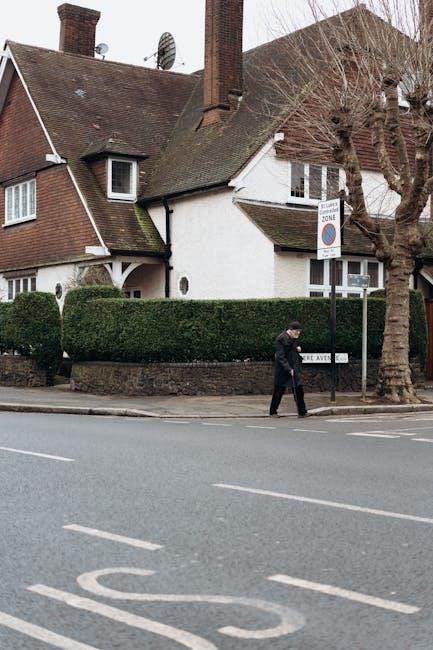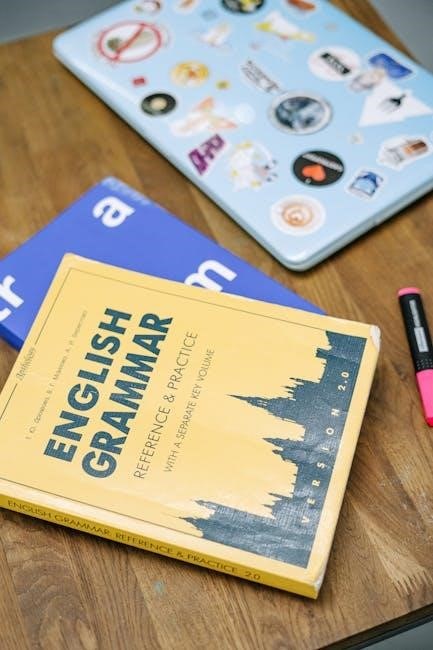The 12 English tenses are essential for clear communication, categorised into past, present, and future, each with simple, continuous, perfect, and perfect continuous aspects.
Purpose and Importance of Learning English Tenses
Mastering the 12 English tenses is crucial for effective communication, as they enable speakers and writers to express actions clearly across different time frames. Tenses help convey when an action occurs, making conversations and writing precise and meaningful. Understanding these tenses enhances grammar skills, improving both spoken and written English. They are foundational for constructing logical sentences, ensuring clarity and avoiding misunderstandings. Learning tenses also boosts confidence in language use, making interactions smoother and more professional. With structured practice and resources like PDF materials and exercises, anyone can grasp these essential grammar components, unlocking clearer expression and better comprehension in English.
Overview of the 12 Tenses in English Grammar
The 12 English tenses are divided into four categories: simple, continuous, perfect, and perfect continuous, each spanning past, present, and future. Simple tenses describe straightforward actions, while continuous tenses emphasize ongoing processes. Perfect tenses highlight completed actions, and perfect continuous tenses focus on duration. Together, they provide a framework to express actions with precision, from habitual routines to future plans. This structured system allows speakers to convey time and aspect clearly, making English communication both nuanced and effective. Understanding each tense’s role is key to mastering English grammar and enhancing overall language proficiency through practice and study.

Present Tenses
The present tenses describe current actions, habits, or ongoing events, divided into four categories: simple, continuous, perfect, and perfect continuous, each with distinct structures and uses.
Simple Present Tense: Structure, Usage, and Examples
The simple present tense is used to describe habits, general truths, and regular actions. Its structure is straightforward: subject + base verb (e.g., “She plays soccer”).
- Usage:
- Habits: “I read books every evening.”
- Universal truths: “The sun rises in the east.”
- Fixed schedules: “The train leaves at 8 PM.”
- Examples:
- Affirmative: “He works in an office.”
- Negative: “They do not live here.”
- Question: “Does she study French?”
This tense is vital for conveying routine and timeless actions.
Present Continuous Tense: Structure, Usage, and Examples
The present continuous tense describes actions ongoing at the moment of speaking. Its structure is am/is/are + verb-ing (e.g., “They are studying”).
- Usage:
- Actions happening now: “She is cooking dinner.”
- Temporary situations: “He is staying with friends.”
- Planned future events: “We are meeting tomorrow.”
- Examples:
- Affirmative: “I am reading a book.”
- Negative: “They are not playing outside.”
- Question: “Are you working today?”

This tense highlights actions in progress, emphasizing their temporary nature.

Present Perfect and Present Perfect Continuous Tenses: Structure and Usage
The present perfect tense uses have/has + past participle (e.g., “She has completed her task”). It denotes actions completed at an unspecified time before now.
The present perfect continuous tense uses have/has been + verb-ing (e.g., “He has been working”). It emphasizes the duration of an action that started in the past and continues now.
- Usage:
- Experience: “I have visited Paris.”
- Actions continuing from past to present: “They have been living here.”
- Recent actions: “He has just finished.”
Both tenses connect the past to the present, highlighting completion or continuity.

Past Tenses
The past tenses—simple, continuous, perfect, and perfect continuous—describe actions that occurred before the present. They clarify completion, duration, or sequence of past events with precision.
Simple Past Tense: Structure, Usage, and Examples
The simple past tense is formed using the base form of the verb, typically with irregular verbs or by adding “-d” or “-ed” to regular verbs. For example, “walk” becomes “walked,” while “sing” becomes “sang.” This tense is used to describe completed actions in the past, such as She left for work yesterday or They visited Paris last summer. It is often used with time expressions like yesterday, last night, or ago. The simple past tense does not indicate whether the action was ongoing or repeated; it simply states that the action occurred and was completed. It is essential for storytelling and discussing past events.
Past Continuous Tense: Structure, Usage, and Examples
The past continuous tense is formed with was/were plus the present participle of the verb, e.g., She was reading or They were traveling. This tense describes actions that were ongoing at a specific time in the past and emphasizes the duration of the activity. For instance, I was studying at 8 PM last night highlights that the action was in progress but does not necessarily indicate its completion. It is often used to set the scene for another action, such as While I was cooking, the phone rang. The past continuous is also used to show simultaneous actions in the past, like He was playing guitar while she was singing.
Past Perfect and Past Perfect Continuous Tenses: Structure and Usage
The past perfect tense is formed with had plus the past participle, e.g., She had finished. It is used to indicate an action completed before another past action, such as When they arrived, the train had already left. The past perfect continuous tense uses had been plus the present participle, e.g., He had been working. It emphasizes the duration of an action that occurred before another past event, like She had been studying for hours before she took a break. These tenses are essential for showing sequence and relationship between past events, highlighting either completion or ongoing action.

Future Tenses
The future tenses express actions yet to occur, including the simple future (will/won’t), future continuous (will be), future perfect (will have), and future perfect continuous (will have been).
Simple Future Tense: Structure, Usage, and Examples
The simple future tense is formed using “will” or “shall” followed by the base form of the verb. For example, She will travel to Paris next week. The negative form uses “will not” or “won’t”, as in They won’t attend the meeting.
This tense is used to express future facts, predictions, or spontaneous decisions. For instance, It will rain tomorrow (future fact) or I think I will call him later (spontaneous decision). It is also used for promises or offers, such as I will help you with your homework.
Examples:
– He will finish his project by Friday.
– They won’t need tickets for the event.
– Will you join us for dinner?
The simple future tense is versatile and essential for discussing future plans and events.
Future Continuous Tense: Structure, Usage, and Examples
The future continuous tense is formed using “will be” followed by the present participle (verb-ing). For example, She will be studying at this time tomorrow. The negative form is “will not be”, as in They won’t be attending the meeting.
This tense describes actions that will be in progress at a specific time in the future. It is also used to express actions that will be interrupted by another action. For instance, I will be working while they are traveling; Additionally, it is used for polite questions about future plans, such as Will you be joining us for dinner?.
Examples:
– He will be playing tennis at 5 PM tomorrow.
– They won’t be watching the movie tonight.
– Will you be available for a meeting next Monday?
This tense is ideal for describing ongoing future actions and their interruptions.
Future Perfect and Future Perfect Continuous Tenses: Structure and Usage

The future perfect tense is formed with “will have” + the past participle, e.g., She will have completed her assignment by tomorrow. It is used to describe actions that will be finished before a specific point in the future.

The future perfect continuous tense uses “will have been” + the present participle, e.g., He will have been studying for hours by the time you arrive. It emphasizes the duration of an action that will continue up to a point in the future.
Both tenses are used to connect future actions with specific time references, clarifying when and how long actions will occur. Examples:
– I will have finished my project by next week.
– They will have been traveling for three months by December.
These tenses help in expressing the relationship between actions and their completion or duration in the future.

Resources and Practice for Mastering the 12 Tenses
Downloadable PDF materials, worksheets, and online exercises provide comprehensive practice. These resources include grammar notes, drills, and quizzes to enhance understanding and mastery of all 12 tenses effectively.
Recommended PDF Materials and Worksheets
Download comprehensive PDF guides and worksheets to master the 12 English tenses. These resources include detailed explanations, examples, and exercises tailored for all skill levels.
Materials like “12 Tenses Pdf Notes & Documents with Exercises” offer structured lessons, grammar rules, and practice drills. Worksheets cover simple, continuous, perfect, and perfect continuous tenses, ensuring thorough understanding.
Additionally, PDFs provide charts, MCQs, and quizzes to test knowledge. Ideal for self-study, these resources are perfect for learners seeking to enhance grammar skills effectively.

Exercises and Quizzes to Test Your Knowledge
Enhance your understanding of the 12 English tenses with targeted exercises and quizzes. These resources include simple drills, gap-fill activities, and sentence-writing tasks to reinforce learning.
Multiple-choice questions and interactive tests are available to assess mastery of each tense. Worksheets often feature answer sheets for self-assessment, helping learners identify areas for improvement.
Regular practice with these exercises ensures fluency and accuracy in using the tenses effectively in both writing and speaking. Quizzes are designed to cover all aspects, from simple to perfect continuous forms, making them ideal for consistent practice.